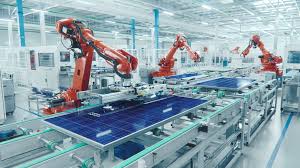The manufacturing industry has undergone significant transformations over the past few decades, and one of the most pivotal changes has been the integration of robotics. Robotics in manufacturing has evolved from simple, repetitive tasks to more advanced systems that are capable of performing complex operations with precision, speed, and flexibility. As industries around the world continue to pursue higher efficiency and productivity, robots have become essential tools that help companies stay competitive, reduce costs, and improve product quality.
This article explores how robotics are transforming manufacturing processes and how they can drive significant improvements in efficiency and productivity. We’ll also highlight the different types of robots used in manufacturing and examine the specific areas where robots can make the most impact.
The Role of Robotics in Manufacturing
Robots are machines designed to carry out tasks autonomously or semi-autonomously, often with little or no human intervention. In the context of manufacturing, robots are used to perform a wide range of tasks, including assembly, welding, painting, material handling, packaging, and quality control. These robots are typically designed to operate in a highly controlled environment where they can perform repetitive tasks more consistently and accurately than human workers.
Types of Robots in Manufacturing
There are several types of robots used in manufacturing, each designed for different tasks:
- Industrial Robots: These are the most common type of robot used in manufacturing, designed to handle repetitive tasks such as welding, painting, and assembly. They are typically mounted on robotic arms and can move along multiple axes to perform precise movements.
- Collaborative Robots (Cobots): Unlike traditional robots that work independently, cobots are designed to work alongside human workers. These robots are often smaller, more flexible, and equipped with sensors to ensure safety when working in close proximity to people.
- Autonomous Mobile Robots (AMRs): AMRs are used to transport materials and goods around the manufacturing facility. They navigate autonomously, often using sensors, cameras, and artificial intelligence (AI) to avoid obstacles and find the most efficient path.
- Delta Robots: These are high-speed robots commonly used for picking and packaging tasks. Their lightweight, three-armed design allows them to perform tasks with great speed and precision.
- SCARA Robots: Selective Compliance Assembly Robots (SCARA) are used for assembly tasks that require precise movements. They are often employed in tasks like inserting components into parts and packaging.
How Robotics Improve Efficiency in Manufacturing
1. Automation of Repetitive Tasks
One of the most significant advantages of robotics in manufacturing is their ability to perform repetitive tasks without fatigue. Robots can work 24/7 without breaks, and unlike humans, they don’t suffer from physical or mental fatigue. This leads to consistent, high-quality production with minimal errors, reducing the need for human intervention in basic tasks.
Examples:
- Assembly Lines: In industries like automotive manufacturing, robots can carry out assembly tasks such as installing parts, welding, or screwing components together. This minimizes human error and ensures high-quality, consistent results.
- Material Handling: Robots can handle materials and components with precision and speed, reducing the time it takes to move parts from one part of the production line to another. This also reduces the risk of injury to human workers.
2. Enhanced Precision and Accuracy
Robots are capable of performing tasks with a high degree of precision that human workers cannot match. This is especially important in industries like electronics or aerospace, where even the smallest deviation can lead to significant defects or failures.
Examples:
- Welding and Cutting: Robots equipped with lasers or other cutting tools can make exact cuts and welds, resulting in a higher level of quality control. These robots can also perform intricate tasks that would be difficult for a human to replicate consistently.
- Quality Control: Robots can be equipped with vision systems and sensors to detect defects in products. For instance, robots can inspect circuit boards for visual defects, or use laser scanning to measure dimensions of a part, ensuring that only defect-free products are passed to the next stage.
3. Reduction of Downtime
Downtime is one of the biggest challenges in manufacturing. It occurs when machinery or workers are unable to perform tasks due to maintenance needs, errors, or material shortages. Robots can reduce downtime in a variety of ways:
- Predictive Maintenance: Many industrial robots are equipped with sensors that monitor their condition in real-time. This data can be used to predict when a robot will need maintenance, allowing for scheduled downtime rather than unexpected breakdowns.
- Minimizing Errors: Since robots perform tasks with high accuracy, there is less likelihood of errors that might require halting the production process. This leads to less downtime for rework or corrections.
4. Increased Speed of Production
Robots can work faster than humans in many manufacturing processes. Their ability to perform tasks with high speed and precision means that production cycles are shortened, resulting in increased throughput.
Examples:
- Packaging and Sorting: Robots can quickly pick, package, and sort products. This is especially useful in industries like food processing, e-commerce, and pharmaceuticals, where speed and efficiency are critical.
- Automated Assembly: Robots can assemble components or products much faster than humans, reducing the overall time it takes to build a product and enabling manufacturers to meet high demand without sacrificing quality.
5. Improved Safety
Robots improve safety in manufacturing by taking over dangerous tasks that would otherwise put human workers at risk. Many manufacturing environments involve hazardous materials, heavy lifting, or machinery that could cause injury if not handled properly. Robots can take on these tasks, reducing the risk of workplace accidents and injuries.
Examples:
- Handling Hazardous Materials: In industries such as chemicals, robots can be used to transport and handle dangerous substances, reducing the risk to human workers.
- Lifting Heavy Objects: Robots are often used for lifting heavy parts and products, preventing workers from experiencing injuries related to manual lifting.
How Robotics Improve Productivity in Manufacturing
1. Customization and Flexibility
The need for mass customization in today’s global markets has made flexibility an essential component of manufacturing. Robotics can adapt to different production needs and even switch between different tasks quickly.
Examples:
- Flexible Manufacturing: Robotic systems can be reprogrammed or reconfigured for different products, allowing manufacturers to quickly adapt to changing customer demands without incurring large downtime or retraining costs.
- Rapid Prototyping: Robotics can be used in prototyping processes, allowing manufacturers to design and test new products quickly and efficiently.
2. Reduction of Labor Costs
While the initial investment in robotic systems may be high, they can lead to long-term cost savings by reducing the need for human labor and increasing overall production output.
- Lower Operational Costs: Robots can work continuously without breaks, and they don’t require salaries, benefits, or health insurance like human workers. Additionally, they can reduce waste and inefficiency, which can further cut costs.
- Scalability: Once a robotic system is implemented, it can be scaled up or down to meet production demands without the need to hire additional employees.
3. Data-Driven Insights
Robots generate valuable data during the manufacturing process, which can be used for continuous improvement. Advanced robotics systems are often equipped with sensors and data analytics capabilities that allow manufacturers to track and analyze performance in real-time.
- Optimization of Production: The data gathered by robots can be used to optimize processes, predict potential inefficiencies, and improve workflows. This real-time feedback allows for better decision-making and resource management.
- Continuous Improvement: Over time, the data from robotic systems can be used to refine manufacturing processes, reduce waste, and improve product quality.
Challenges of Implementing Robotics in Manufacturing
While robotics offer numerous benefits, the implementation of robotic systems comes with challenges that manufacturers must consider:
- High Initial Investment: The cost of purchasing and installing robotic systems can be significant, especially for small and medium-sized enterprises (SMEs). However, many companies find that the long-term cost savings justify the initial investment.
- Workforce Training: As robots become more integrated into manufacturing, employees must be trained to work with these systems, troubleshoot issues, and monitor robotic performance.
- Technical Challenges: Robotic systems require ongoing maintenance and occasional upgrades to ensure they function optimally. Manufacturers must have the necessary technical expertise to handle these needs.
Conclusion
Robotics is fundamentally changing the landscape of manufacturing, driving improvements in efficiency, speed, safety, and product quality. From automating repetitive tasks to enhancing precision and enabling real-time data analysis, robots are helping manufacturers meet the demands of an increasingly competitive and fast-paced global market. While there are challenges, including high initial costs and the need for workforce training, the long-term benefits of robotic systems far outweigh the drawbacks.
The continued evolution of robotics, coupled with advances in artificial intelligence, machine learning, and automation, will likely further enhance productivity in manufacturing, ensuring that this sector remains at the forefront of innovation. With the right strategies, companies can leverage robotics to improve both their operational efficiency and bottom line, setting themselves up for success in the future of manufacturing.


Autocad crack
Autocad 2025
autodesk autocad crack
auto cad crack
fl studio crack
fl studio 2025
idm crack
idm 2025
Internet Download Manager crack
revit crack
autodesk revit 2025
autodesk revit crack
photoshop crack
phohoshop 2025
adobe photoshop crack
photoshop keygen
photoshop free
photoshop crack
adobe photoshop crack
acrobat crack
adobe acrobat crack
premiere pro crack
adobe premiere pro crack
filmora crack
filmora crack 2025
Lightroom crack
adobe Lightroom crack
adobe after effects crack
after effects crack
illustrator crack
adobe illustrator crack
disk drill crack
JetBrains crack
JetBrains PyCharm crack
Wallpaper Engine crack
Wallpaper Engine free 2025
valorant hack 2025
valorant aimbot
valorant cheat
capcut crack
capcut pro crack